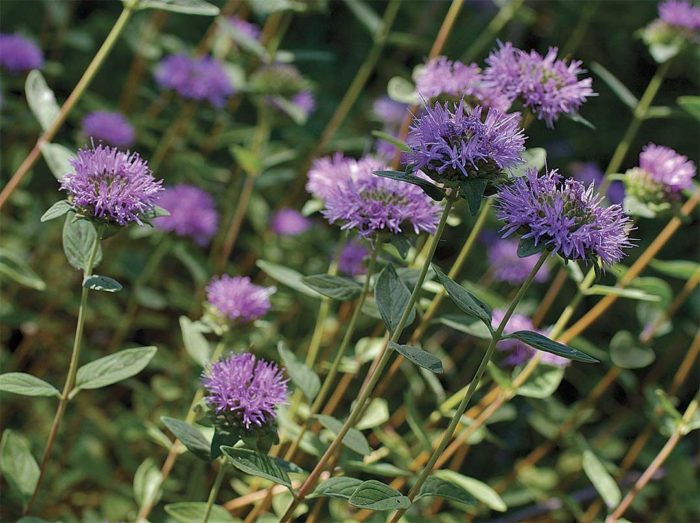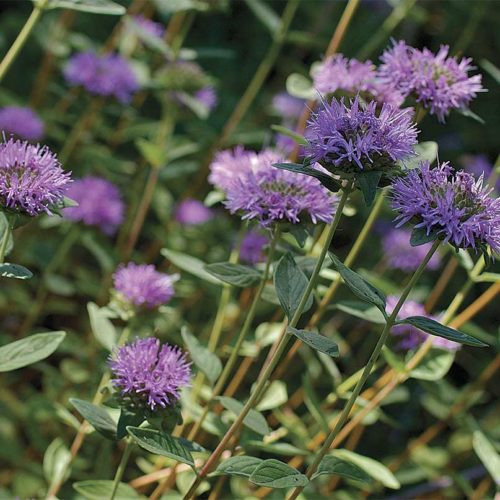
Best Fragrant Perennials – Central California
Name: Clinopodium douglasii (syn. Satureja douglasii)
USDA Hardiness Zones: 7 to 10
Size: Up to 6 inches tall and spreading to 4 feet wide or more
Conditions: Partial to full shade; seasonally or regularly moist soil
Yerba buena may be the finest tea herb that California has to offer. An intoxicatingly fresh lemon scent invigorates and soothes at once. Creeping and scrambling, its stems root where they touch, creating extensive colonies in time. Small white flowers from spring to summer are visited by bees and even draw hummingbirds to ground level. It is an excellent kitchen herb and ground cover under potted plants or among larger perennials. Yerba buena loves regular water but can take long dry periods, especially when planted in shade. It survives short frosts, occurring as far north as Vancouver, Washington.
Name: Solanum xantii
Zones: 8 to 11
Size: 2 to 3 feet tall and 3 feet wide
Conditions: Full sun to partial shade; dry, rocky soil (but tolerant of most soils)
While there are many gardenworthy nightshades nationwide, this small, gray-leaved, gray-stemmed species is an excellent one for the hot, dry parts of the garden. Its downy leaves
reflect some light, keeping the plant cooler and restricting water loss at the same time.
Tougher in drought than many of its close cousins, chaparral nightshade has flowers that produce a beautiful, delicate smell, similar to that of jasmine. The gentle odor is most noticeable at dusk and dawn. Its flowers are translucent lavender, borne in clusters and often nodding toward the ground. Chaparral nightshade is one of the first plants to wake and begin blooming with California’s autumn rains. It continues to bloom through most of winter and spring.
Name: Salvia spathacea
Zones: 7 to 10
Size: 1 to 2 feet tall, slowly spreads to form colonies at least 4 feet wide
Conditions: Shade is best or some sun with summer water; wide soil tolerance
Hummingbird sage, besides having a gorgeous spring bloom, is adored by hummingbirds, bees, and butterflies. It is one of the best plants for dry shade and is an essential ground cover under mature trees in Southern California. Slowly spreading by underground runners, plants can fill large areas. Very drought tolerant in shade, it does respond well to modest
irrigation. Each rosette of leaves sends up a large flower stalk (up to 3 feet tall) with whorls of many small magenta flowers. Both leaves and stalks are intensely fragrant. Hummingbird sage enjoys deep leaf litter, although it also does well in formal beds.
Name: Monardella villosa ‘Russian River’
Zones: 8 to 11
Size: 1 to 2 feet tall and 2 to 3 feet wide
Conditions: Full sun to partial shade; wide soil tolerance
This excellent evergreen perennial for hot, dry parts of the garden was found near the
Russian River in Sonoma County, California. Its small oval leaves have a wonderfully fresh, minty smell, like (yet unlike) the garden mints from Europe. ‘Russian River’ coyote mint emits a powerful but lovely scent with the slightest brush against its leaves. Just as wonderful are the bright purple-pink heads of small flowers that adorn every stem tip in late spring and summer. Attractive to bees, butterflies, and hummingbirds, ‘Russian River’ works well as a cut flower, and the leaves work well in nosegays and potpourri.





















Comments
Log in or create an account to post a comment.
Sign up Log in